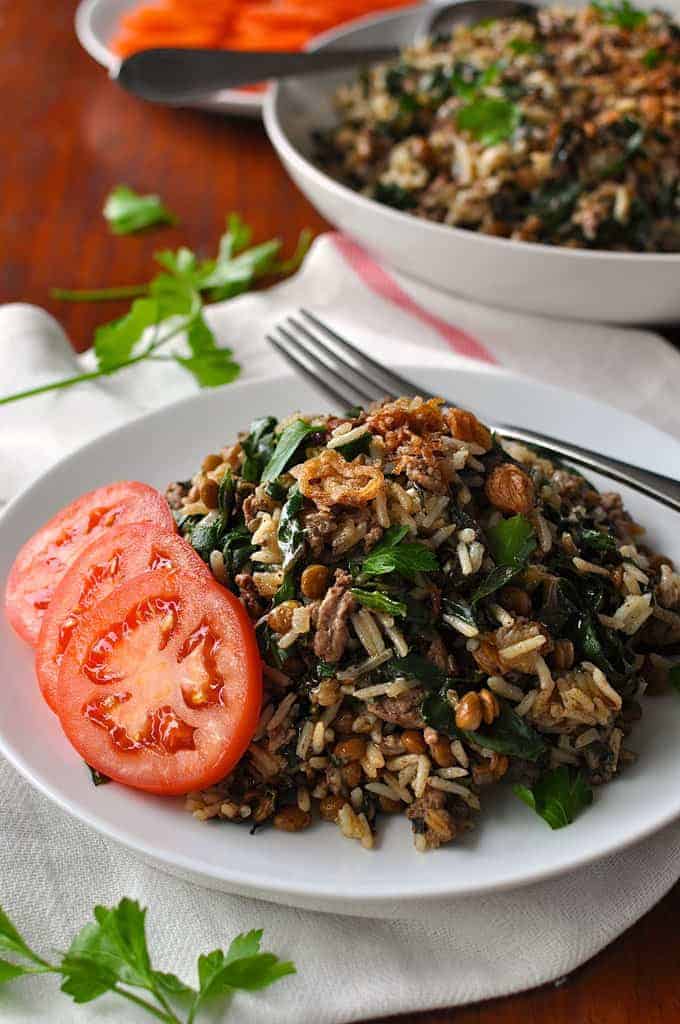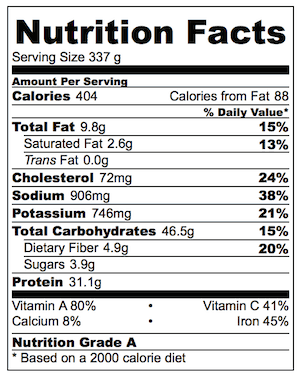Wikipedia says “A Pilaf is a dish in which rice is cooked in a seasoned broth.” That’s exactly what this dish is. Lamb mince and spinach cooked with rice seasoned with Middle Eastern spices. Hence it’s name – Middle Eastern Lamb and Lentil Rice Pilaf. I’ve repeatedly professed my love for Middle Eastern food. It’s the spices that does it for me. I find the smell and flavour of Middle Eastern spices irresistible. If you have a stash of cumin, coriander, paprika, turmeric, cardamon and cinnamon, you’ll have the flavourings for the majority of Middle Eastern dishes. You’ll be surprised at the quantity of greens “hidden” in this pilaf. There are 6 cups of silverbeet (chard) – packed cups! It looks like a huge mound when you chop it but it wilts significantly, as you can see in the photo above. I alternate between spinach and silverbeet in this recipe depending on price as they can vary quite a lot. You’ll need 1 1/2 to 2 bunches of spinach, or about 1/2 – 3/4 a bunch of silverbeet (leaves only). Even with that much silverbeet, my Middle Eastern Lamb and Lentil Rice Pilaf itself only has a Nutrition Grade rating of “B” (I ran it through a Nutritional Analysis). The challenge I find with coming up with fresh ideas for one pot meals is making sure that they are a complete meal. To me, a complete meal is one with a Nutrition Grade rating of A. So if you serve this with a few juicy slices of tomato (just plain, no dressing), it brings it up to A. This pilaf is so aromatic that plain slices of tomato are the perfect accompaniment to bring a burst of freshness to this meal. Food Geek Stuff: This is the section where I prattle on about logic for why I do things a certain way, what works and what doesn’t. It’s kind of sharing my lessons learned from all the attempts and failures making this over the years. Those that aren’t interested can skip right over it and get to the recipe! a) Silverbeet (chard) – I made this one using silverbeet because that’s what I had. Silverbeet leaves are thicker than spinach so the steps are slightly different. My preference is to tear the green leaves off the white stems because the stems take longer to cook and you’ll end up with slightly crunchy bits in the pilaf. If you don’t mind that, then include the stem but I recommend slicing it finely. Silverbeet cooked with the rice tends to turn brown. So to keep the colour of this dish more appealing, I only cook half the silverbeet with the rice, then I add the other half while the rice is resting – just spread it over the top of the rice and clamp the lid back on. The residual heat wilts the spinach while the rice is resting, then stir it through. Why only half? Because silverbeet has thicker leaves than spinach and when I tried “steaming” all of it using the residual heat, it did not wilt very much. b) Spinach – spinach leaves are more delicate than silverbeet, so it is best added after the rice has cooked otherwise it wilts so much that it almost disappears and also turns a bit brownish. So when using spinach, I add all of it to the resting rice. c) Water quantity – when making pilaf, you need to get the water quantity right because different meats and vegetables absorb and release different quantities of liquid. To cook plain rice, typically the ratio is 1 cup of rice to 1 1/2 cups of water. In this recipe, when you pour the water in with the rice, meat, lentils and silverbeet, it will probably look like there is not enough water. But the silverbeet and lentils cooked with the rice releases a bit of water, plus the silverbeet (or spinach) that is added to the resting rice releases a small amount of liquid as well which is absorbed. So the combination of these factors contribute to the liquid content to produce a perfectly al dente rice pilaf. d) Adding more vegetables – if you want to add more vegetables, you need to take into account the effect of watery vegetables on the water to rice ratio. Too much liquid will result in overcooked rice which is sticky and gluggy. For example, peas and carrots will not release nor absorb (much) liquid so no adjustment is required. They can simply be added when you add the rice. But zucchinis, eggplants and capsicums (bell peppers) have a high water content. So if you want to add vegetables with a high water content to this recipe, you need to sauté them separately, then set aside to add later when you are adding the rice. The reason you have to sauté them separately is because with the quantity of ingredients already in this recipe, adding more vegetables will crowd the pan and you’ll end up “stewing” everything instead of sautéing it. Who here likes stewed mince? Not me! e) Other meats – this dish is just as fabulous made with beef mince (ground beef). Lamb is best because the flavour of lamb is quite strong which goes well with these aromatic spices. The strength of the spice flavour is the reason why I don’t think chicken mince is suitable because you just won’t taste any chicken at all! f) Vegetarian – yes, this dish is great to make into a vegetarian dish. Substitute the lamb with more vegetables (follow d) above) or just omit altogether. Great vegetables to add are: grated or diced carrot, zucchini and eggplant. OK, enough with the foodie geek stuff! Here’s the recipe. It serves 4 normal servings or 5 smaller servings. Love to hear if you try it and what you think! I always love getting feedback (constructive criticism is always welcome :)). SaveSave SaveSave

